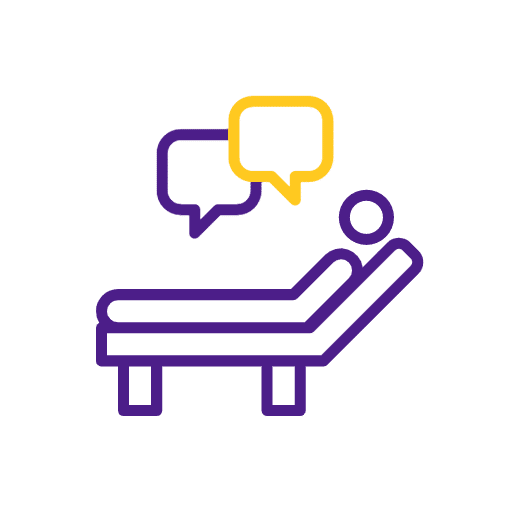Types, Causes, and Treatment
A mood disorder, also known as an affective disorder, is a mental health condition characterized by significant disturbances in a person’s emotional state or mood. These disorders can manifest as persistent feelings of sadness, hopelessness, or extreme mood swings that can impact an individual’s daily functioning, relationships, and overall quality of life.
Timely intervention and appropriate treatment for a mood disorder can significantly improve an individual’s quality of life and emotional well-being. This article will discuss the different types of mood disorders and how they can be treated.

Understanding Mood Disorders:
Types, Causes, and Treatment
A mood disorder, also known as an affective disorder, is a mental health condition characterized by significant disturbances in a person’s emotional state or mood. These disorders can manifest as persistent feelings of sadness, hopelessness, or extreme mood swings that can impact an individual’s daily functioning, relationships, and overall quality of life.
Timely intervention and appropriate treatment for a mood disorder can significantly improve an individual’s quality of life and emotional well-being. This article will discuss the different types of mood disorders and how they can be treated.
Home » Treatments » Mood Disorders: Types, Causes, and Treatment
What is a Mood Disorder?
Mood disorders, also known as affective disorders, are a group of mental health conditions characterized by significant disturbances in a person’s emotional state or mood. These disorders can impact daily functioning, relationships, and overall quality of life. Mood disorders can be caused by a combination of genetic, biological, environmental, and psychological factors. It’s crucial to identify and address mood disorders early on, as they can lead to a higher risk of developing other mental health issues, substance abuse, and even suicidal thoughts or actions.
Risk Factors for Mood Disorders
There are various factors that can increase an individual’s risk of developing a mood disorder. Understanding these risk factors can help in early identification and intervention, ultimately improving the prognosis for those affected. Some of the most common risk factors for mood disorders include:
Genetic predisposition
Individuals with a family history of mood disorders are at a higher risk of developing a mood disorder themselves. While genetic factors may play a role, it does not follow the typical pattern in which genetic traits are passed down (Mendelian pattern) and therefore is a complex risk factor.
Biochemical imbalances
Imbalances in neurotransmitters, such as serotonin, dopamine, and norepinephrine, can contribute to the development of mood disorders.
Hormonal imbalances
Changes in hormone levels, such as during pregnancy, menopause, or as a result of thyroid disorders, can increase the risk of mood disorders.
Substance abuse
The use of drugs or alcohol can exacerbate existing mood disorders or trigger the onset of new ones. Substance abuse can also interfere with the effectiveness of treatment for mood disorders.
Traumatic events
Experiencing a traumatic event, such as physical or sexual abuse, a natural disaster, or the loss of a loved one, can increase the risk of developing a mood disorder.
Chronic stress
Persistent stress can take a toll on mental health and contribute to the development of mood disorders. This may include ongoing work-related stress, relationship difficulties, or financial strain.
Medical conditions
Certain medical conditions, such as chronic pain, neurological disorders, or autoimmune diseases, can increase the risk of developing mood disorders.
Social isolation
A lack of social support and feelings of loneliness can contribute to the development and worsening of mood disorders.
Adverse childhood experiences
Exposure to negative experiences in childhood, such as abuse, neglect, or witnessing domestic violence, can increase the likelihood of developing a mood disorder later in life.
Personality traits
Certain personality traits, such as high levels of neuroticism or pessimism, may make individuals more susceptible to mood disorders.
It’s essential to remember that having one or more risk factors does not guarantee that someone will develop a mood disorder. However, recognizing these risk factors can help individuals and their healthcare providers take appropriate steps to monitor and address potential concerns.
Types of Mood Disorders
There is a wide range of mood disorders, and understanding the different types is essential for proper diagnosis and treatment. Some of the most common mood disorders include:
Major Depressive Disorder
Major depressive disorder, or depression, is characterized by persistent feelings of sadness, hopelessness, and a lack of interest in activities. Symptoms may include changes in appetite, sleep patterns, energy levels, and concentration, as well as feelings of guilt or worthlessness. These symptoms must persist for at least two weeks for a diagnosis of MDD. Depression can be debilitating, making it difficult for those affected to carry out everyday tasks and engage in social interactions. Early intervention and appropriate treatment can significantly improve the prognosis for those with MDD.
Bipolar Disorder
Bipolar disorder involves extreme mood swings, including periods of mania and depression. Manic episodes are characterized by elevated mood, increased energy, and impulsive behavior, while depressive episodes feature symptoms similar to those of MDD. Different types of bipolar disorder include Bipolar I, Bipolar II, and Cyclothymic Disorder, which differ in the severity and duration of mood episodes. Bipolar disorder can disrupt daily life and relationships, so it’s essential to receive a proper diagnosis and treatment to manage symptoms effectively.
Persistent Depressive Disorder (Dysthymia)
Dysthymia is a chronic form of depression that lasts for at least two years. Symptoms are generally milder than those of depression but can still significantly impact a person’s life. Individuals with dysthymia may experience a loss of interest in activities, feelings of hopelessness, low self-esteem, and difficulty concentrating. Because dysthymia is a long-lasting condition, it can be challenging to recognize and diagnose. Timely intervention and treatment can help alleviate symptoms and improve overall well-being.
Seasonal Affective Disorder (SAD)
SAD is a type of depression that typically occurs during the fall and winter months when there is less sunlight. Symptoms usually improve during the spring and summer. Common signs of seasonal affective disorder include low energy, oversleeping, appetite changes, and feelings of sadness or hopelessness. Treatment options for SAD may include light therapy, psychotherapy, and medications.
Premenstrual Dysphoric Disorder
Premenstrual dysphoric disorder (PMDD) is a severe form of premenstrual syndrome that causes significant emotional and physical symptoms, typically in the week before menstruation. Women with PMDD may experience extreme mood swings, irritability, anxiety, and physical symptoms such as bloating, breast tenderness, and headaches.
Disruptive Mood Dysregulation Disorder
Disruptive mood dysregulation disorder (DMDD) is a childhood mood disorder characterized by persistent irritability and frequent episodes of extreme, out-of-control anger or tantrums. Children with DMDD struggle to regulate their emotions, which can lead to problems at school, with peers, and within the family. Early intervention and appropriate treatment, such as psychotherapy and behavioral modification techniques, are crucial to help children with DMDD develop healthy emotional regulation skills and improve their overall well-being.
Treatment for Mood Disorders
Seeking treatment for a mood disorder is crucial for several reasons. Untreated mood disorders can lead to a decline in mental, emotional, and physical health, making it increasingly difficult for the affected individual to manage their daily responsibilities and maintain healthy relationships. Additionally, untreated mood disorders can increase the risk of developing other health issues, such as substance abuse, chronic physical illnesses, and suicidal ideation or behavior.
Some of the most common treatments for mood disorders include:

Psychotherapy
Cognitive Behavioral Therapy (CBT)
CBT helps individuals identify and change negative thought patterns and behaviors that contribute to mood disorders. It focuses on developing healthy coping strategies and problem-solving skills to improve emotional well-being.
Interpersonal Therapy (IPT)
IPT addresses interpersonal issues that contribute to mood disorders, such as relationship conflicts or social isolation. It aims to improve communication and relationship-building skills to enhance social support and overall mental health.
Dialectical Behavior Therapy (DBT)
DBT is particularly helpful for individuals with severe mood disorders and those who struggle with self-harm or suicidal thoughts. It combines elements of CBT with mindfulness practices to help clients develop emotional regulation and distress tolerance skills.
Acceptance and Commitment Therapy (ACT)
ACT focuses on fostering psychological flexibility by helping clients accept and cope with difficult emotions while pursuing their values and goals.
Psychodynamic Therapy
This therapy aims to uncover unconscious thoughts and feelings that contribute to mood disorders, helping clients gain insight into their emotional experiences and improve their overall well-being.
Family Therapy
Family therapy addresses the impact of mood disorders on the family system and helps improve communication and support among family members.
Group Therapy
Group therapy provides a supportive environment for individuals with mood disorders to share experiences, learn from others, and develop coping strategies.

Medications
Various medications can be used to treat mood disorders, depending on the specific condition and individual needs. Some common types of medications include:
Antidepressants
(e.g., SSRIs, SNRIs, tricyclic antidepressants, MAOIs) These medications work by regulating neurotransmitters in the brain, helping to improve mood and alleviate symptoms of depression.
Mood stabilizers
(e.g., lithium, valproate, lamotrigine, carbamazepine) Mood stabilizers are commonly used to treat bipolar disorder, as they help to prevent extreme mood swings and maintain emotional stability.
Atypical antipsychotics
These medications are sometimes prescribed alongside other treatments for mood disorders, particularly in cases of severe depression or bipolar disorder.
Anti-anxiety medications
(e.g., benzodiazepines, buspirone) These medications can help to reduce anxiety and agitation associated with mood disorders.
Stimulants
(in some cases, for treatment-resistant depression) In select cases, stimulants may be prescribed to improve energy levels and motivation in individuals with treatment-resistant depression.
Electroconvulsive Therapy (ECT)
ECT is a procedure in which small electric currents are passed through the brain, intentionally triggering a brief seizure. ECT is often used for severe cases of depression or bipolar disorder when other treatments have not been effective.
Repetitive Transcranial Magnetic Stimulation (rTMS)
Repetitive Transcranial Magnetic Stimulation is a non-invasive procedure that uses magnetic fields to stimulate specific regions of the brain. It has been shown to be effective in treating some cases of depression, particularly treatment-resistant depression.
Vagus Nerve Stimulation (VNS)
VNS is a treatment that involves the implantation of a device that sends electrical impulses to the vagus nerve, which then sends signals to the brain. VNS has been found to be effective in treating some cases of treatment-resistant depression.
Light Therapy
Light therapy, or phototherapy, is a treatment for Seasonal Affective Disorder (SAD) that involves exposure to artificial light. The light is typically emitted by a specially designed light box, which can help regulate mood and improve symptoms of SAD.
Lifestyle Changes
Incorporating healthy habits and self-care practices can significantly impact mood and overall mental health. Some recommended lifestyle changes include:
- Regular exercise: Engaging in regular physical activity can help to release endorphins, improve mood, and reduce stress.
- Adequate sleep: Ensuring you get enough restorative sleep each night is essential for maintaining emotional well-being and overall health.
- Balanced diet: Consuming a nutrient-rich diet can help provide the necessary energy and nutrients for optimal brain function and emotional health.
- Stress reduction techniques (e.g., mindfulness, meditation, yoga): Practicing stress reduction techniques can help you manage daily stressors and improve overall emotional well-being.
- Social support and engagement: Building a strong support network and maintaining healthy relationships can be essential for emotional health and recovery from mood disorders.
Complementary and Alternative Treatments for Mood Disorders
Conventional treatments for mood disorders, such as medications, can sometimes cause unwanted side effects. Alternative treatments may offer a more tolerable option for those who are sensitive to these side effects or prefer to avoid medications.
Alternative treatments used for mood disorders include:
Acupuncture
This Traditional Chinese Medicine practice involves inserting thin needles into specific points on the body to help balance energy flow and possibly alleviate symptoms of mood disorders, particularly depression.
Massage therapy
Massage can help to relieve stress, promote relaxation, and improve overall well-being, which may be beneficial for individuals with mood disorders.
Herbal remedies or supplements
Some herbal remedies or supplements, such as St. John’s Wort or Omega-3 fatty acids, may help to alleviate symptoms of mood disorders. However, it’s essential to consult with a healthcare professional before starting any new supplement regimen.
Mind-body practices
(e.g., meditation, deep-breathing exercises, progressive muscle relaxation)
These practices can help individuals with mood disorders learn to cope with stress and improve emotional regulation.
It is important to note that while alternative treatments may be beneficial for some individuals, they should not be seen as a substitute for evidence-based treatments for mood disorders, such as medication and psychotherapy. It is crucial to consult with a mental health professional before starting any alternative treatment to ensure that it is safe and appropriate for your specific needs.
Getting Help for Mood Disorders at Socal Sunrise
At SoCal Sunrise Mental Health, our compassionate and experienced team will work with you to develop a personalized treatment plan that addresses your specific needs and goals. We are committed to providing evidence-based therapies and support to help you regain control of your emotional well-being and live a fulfilling life. Contact us today to learn more about our mood disorder treatment programs and take the first step toward a brighter future.
Clinically Reviewed By:
Joe Cavins, LMFT
Joseph Cavins holds a Bachelor of Science in Human Services from Cal State Fullerton and a Master of Science in Clinical Psychology from Pepperdine Graduate School of Education and Psychology. Initially inspired during his tenure as a school bus driver, Joseph balanced his duties with his studies, demonstrating a strong commitment to his academic pursuits. Post-graduation, he gained significant experience in clinical settings, interning at Aspen Community Services where he later served for 10 years, eventually becoming a Licensed Marriage and Family Therapist. He also earned certification from the Equine Assisted Psychotherapy Association as a Mental Health Provider.
Joseph’s professional journey includes roles in private practice and contracting with the Santa Ana Unified School District’s Special Education Department, culminating in his recent position at Southern California Sunrise Recovery in 2024.